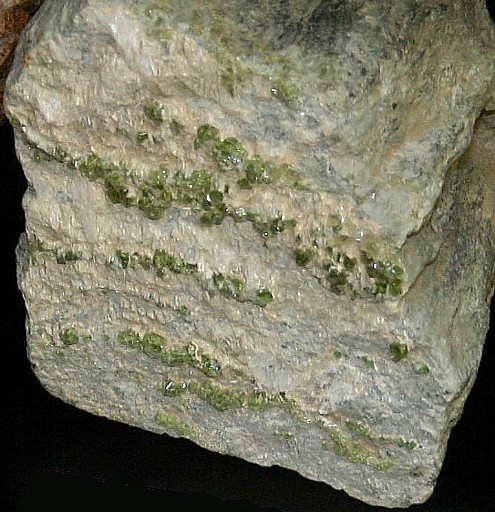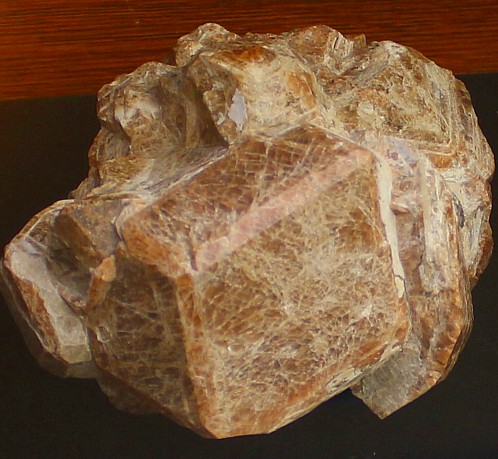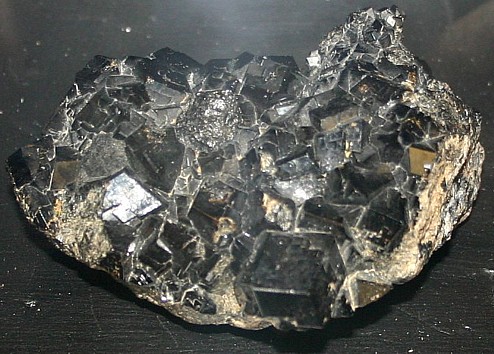|
.
Andradite Mineral Facts:
Chemical Formula:
Ca3Fe2(Si04)3
Calcium-iron garnet. Aluminum
commonly replaces the ferric iron; ferrous iron, manganese and sometimes
magnesium replace a portion of the calcium..
Colors:
Various shades of
yellow, green, brown to black.
The purest varieties are topaz-yellow or light green and transparent.
The former constitute the gem topazolite and the latter, demantoid. The
black variety, melanite, nearly always
contains titanium.
Hardness:
7
Density: 3.3
to 3.8
Cleavage:
None.
Crystallography: Isometric, hexoctahedral
Usually distinctly
crystallized; also in rounded grains; massive granular, coarse or fine.
When crystalized, commonly forms dodecahedron and trapezohedron, often
in combination. Hexoctahedron observed at times.
Luster:.
Vitreous glassy
luster. It is transparent or translucent.
Optics:
(Refractive Index):
=
1.8566
|

Green Andradite Garnet, Variety Demantoid |
|
Composition,
Structure and Associated Minerals:
A
common and widespread mineral, Andradite occurs in igneous and metamorphic
rocks of all kinds, especially in alkaline igneous rocks, in serpentine, in
crystalline schists and in some iron ores. The black titaniferous varieties
are known as schorlomite. Common garnet is a mixture of the grossularite,
almandite and andradite molecules. It occurs in many metamorphosed igneous
rocks and in some slates. It is crushed and employed as abrasive in various
types of sandpaper, finger nail files and grinding wheels.
Identification and Diagnostics
It
is fusible before the blowpipe to a black magnetic mass. Garnets, when in crystals, are easily distinguished
from other similarly crystallizing substances by their characteristic
isometric crystals, color and hardness, etc. Massive garnet may resemble vesuvianite,
sphene, zircon or
tourmaline. It is distinguished from
zircon by its easier fusibility and from vesuvianite by its more difficult
fusibility; from tourmaline by its higher specific gravity, and from sphene
by the reaction from titanium.
It frequently requires a chemical
analysis to positively distinguish between the different members of the
group, or the percentages of each element in an individual specimen.
Occurrence,
Localities and Origins:
Andradite
is a very widely spread and common mineral. It occurs at Franklin, N. J., in
metamorphosed limestone; near Franconia, New Hampshire, in quartz veins, and
at many other places. A black titaniferous variety occurs in a metamorphosed
limestone in southwestern California and near Magnet Cove, in Arkansas. The
variety found at Magnet Cove is schorlomite. It is a black glassy mineral
associated with brookite (TiO2), nepheline, and thomsonite.
Demantoid is a yellowish-green to emerald-green variety of andradite, and
received its name from the fact that its brilliant lustre and dispersive
power recall the appearance of the diamond. The emerald-green variety owes
its color to the presence of chromium. It has a higher refractive index
(1.88) than any other garnet. The yellowish green variety is liable to be
confused with
peridot,
and the emerald-green variety with
emerald;
but demantoid is easily distinguished from these minerals by its isotropic
character and its higher specific gravity. Demantoid occurs in serpentine at
Bobrovka in the Urals, and is there chiefly restricted to veins of
chrysotile asbestos that traverse the mass of serpentine.
Other varities of andradite garnet that are sometimes used as gemstones are
melanite, a black titaniferous variety of andradite found in alkali syenites
and phonolites; and "topazolite" a honey-yellow or topaz-colored variety of
andradite.
Return to the
Mineral Collectors Information Page |

Andradite Garnet |
|



